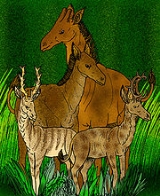
Climacoceratidae
Encyclopedia
Climacoceratidae is a family of superficially deer-like artiodactyl ungulate
s that were restricted to the Miocene
of Africa
. They are close to the ancestry of giraffes
, with some genera, such as Prolibytherium
, having originally identified as being giraffes.
The climacoceratids, namely, of what is now the type genus Climacoceras
, were once originally placed within the family Palaeomerycidae
, and then within Giraffidae
. In 1978, Hamilton erected a new family, placing it close to Giraffidae.
They differ from giraffes, in that the antler
-like ossicone
s are derived from different bones.
Ungulate
Ungulates are several groups of mammals, most of which use the tips of their toes, usually hoofed, to sustain their whole body weight while moving. They make up several orders of mammals, of which six to eight survive...
s that were restricted to the Miocene
Miocene
The Miocene is a geological epoch of the Neogene Period and extends from about . The Miocene was named by Sir Charles Lyell. Its name comes from the Greek words and and means "less recent" because it has 18% fewer modern sea invertebrates than the Pliocene. The Miocene follows the Oligocene...
of Africa
Africa
Africa is the world's second largest and second most populous continent, after Asia. At about 30.2 million km² including adjacent islands, it covers 6% of the Earth's total surface area and 20.4% of the total land area...
. They are close to the ancestry of giraffes
Giraffidae
The giraffids are ruminant artiodactyl mammals that share a common ancestor with deer and bovids. The biological family Giraffidae, once a diverse group spread throughout Eurasia and Africa, contains only two living members, the giraffe and the okapi. Both are confined to sub-saharan Africa: the...
, with some genera, such as Prolibytherium
Prolibytherium
Prolibytherium is an extinct artiodactyl ungulate native to Early Miocene North Africa.The 1.80 m long creature was related to the modern giraffe and okapi. Unlike these, however, Prolibytherium had a set of large, leaf-shaped ossicones with a width of 35 cm...
, having originally identified as being giraffes.
The climacoceratids, namely, of what is now the type genus Climacoceras
Climacoceras
Climacoceras was a genus of early Miocene artiodactyl ungulates of Africa and Europe. The members of Climacoceras were related to giraffes, as the genus was once placed within Giraffidae. Fossils of the two best known species of Climacoceras, C. africanus and C. gentryi have been both found in...
, were once originally placed within the family Palaeomerycidae
Palaeomerycidae
Palaeomerycidae is an extinct family of ruminants , probably ancestral to deer and musk deer...
, and then within Giraffidae
Giraffidae
The giraffids are ruminant artiodactyl mammals that share a common ancestor with deer and bovids. The biological family Giraffidae, once a diverse group spread throughout Eurasia and Africa, contains only two living members, the giraffe and the okapi. Both are confined to sub-saharan Africa: the...
. In 1978, Hamilton erected a new family, placing it close to Giraffidae.
They differ from giraffes, in that the antler
Antler
Antlers are the usually large, branching bony appendages on the heads of most deer species.-Etymology:Antler originally meant the lowest tine, the "brow tine"...
-like ossicone
Ossicone
Ossicones are horn-like protuberances on the heads of giraffes, male okapis, and their extinct relatives, such as Sivatherium, and the climacoceratids, such as Climacoceras. Only giraffids have true ossicones...
s are derived from different bones.

